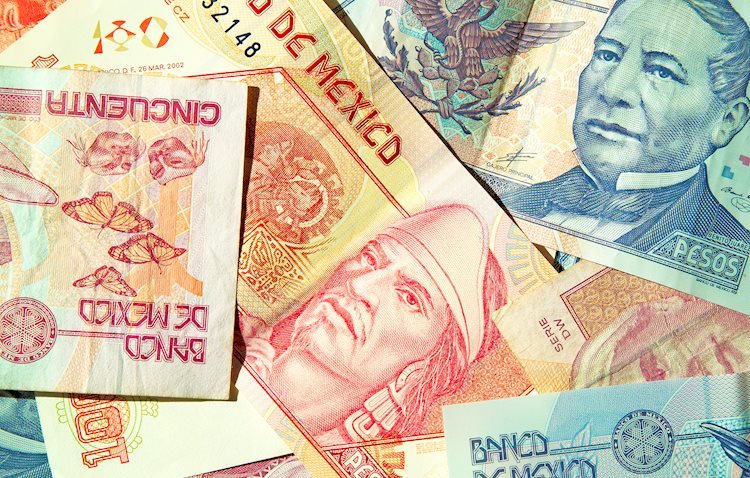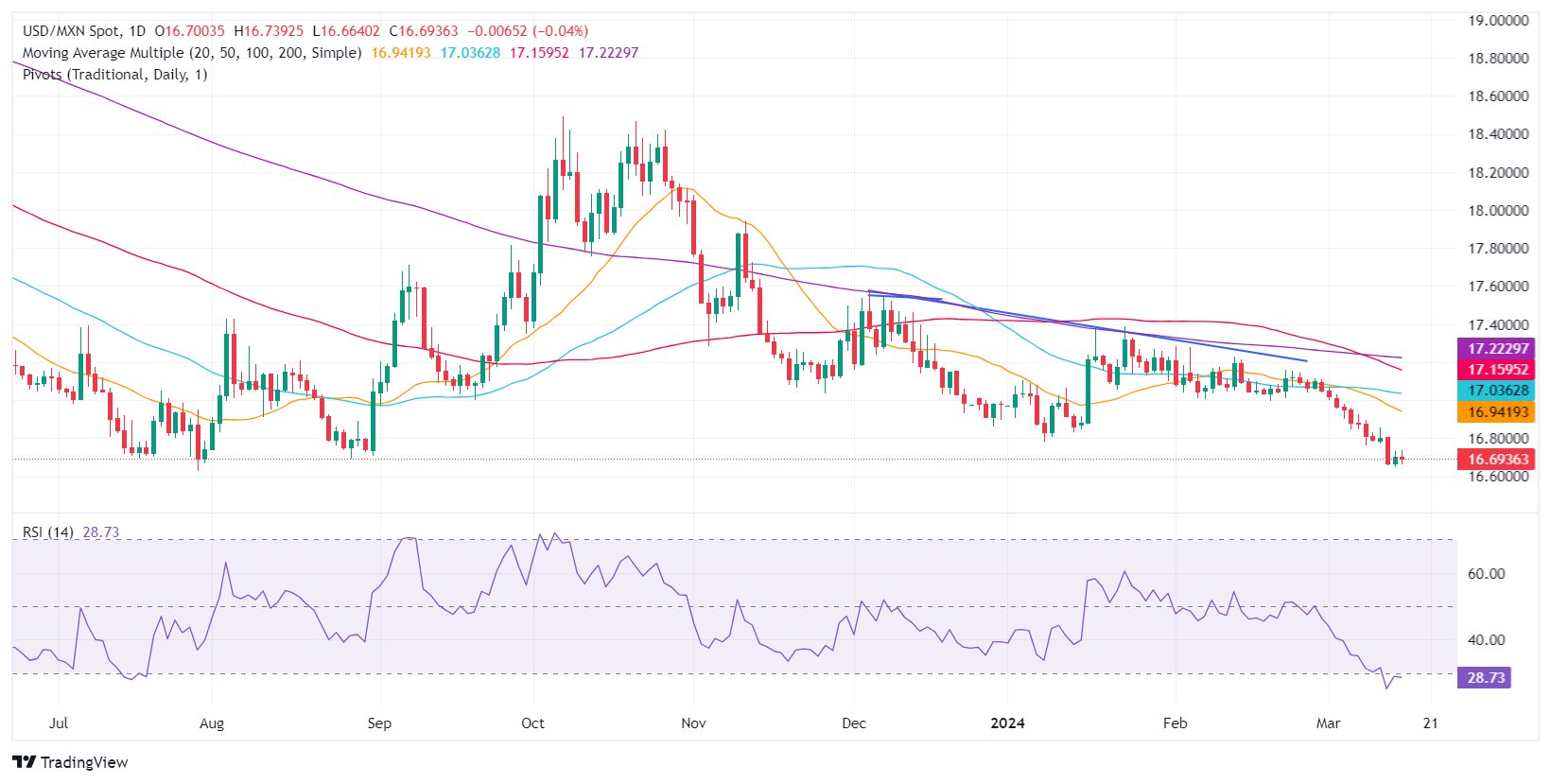- Mexican Peso sees modest uplift as US inflation data tempers Fed easing expectations.
- Industrial Production in Mexico shows resilience, reinforcing views on potential Banxico rate adjustments.
- Deputy Governor Omar Mejia hints at upcoming rate cuts, with a focus on maintaining restrictive monetary policy.
- US Industrial Production recovery and shifts in consumer sentiment barely move the USD/MXN currency pair.
The Mexican Peso (MXN) begins Friday’s session printing minuscule losses against the US Dollar (USD) after hot inflation figures in the United States evaporated traders’ hopes for a rate cut by the US Federal Reserve (Fed). At the time of writing, the USD/MXN exchanges hands at16.71, up by 0.11%.
Mexico’s weekly economic docket witnessed the release of Industrial Production data, which showed a slight improvement despite dealing with high-interest rates of 11.25% set by the Bank of Mexico (Banxico). Two days ago, Banxico’s Deputy Governor, Omar Mejia, commented that a rate cut is possible, adding that it’s not premature and that despite decreasing interest rates, it doesn’t mean monetary policy is not restrictive. The Mexican Central Bank’s next meeting will be on March 21, and market participants anticipate a 25-basis-point rate cut.
Across the border, the US economic docket is slightly busier. The Fed reported that Industrial Production recovered, snapping two consecutive months of decreases. The University of Michigan recently announced that consumer sentiment slightly deteriorated compared to last month’s figures and the consensus.
Daily digest market movers: Mexican Peso counterattacks ahead of Banxico and Fed decisions
- Banxico’s Mejia commented that they have a long way to go on the disinflationary path, though he acknowledged the stickiness of services inflation. He stresses that the balance of risks for inflation is less adverse.
- Mexico’s economic schedule for the next week will feature Aggregate Demand, Private Spending, Retail Sales, Economic Activity, and inflation figures for the first half of March. Besides all this data, the highlight would be Banxico’s interest rate policy decision.
- Banxico’s private analyst poll projections for February were updated. They expect inflation at 4.10%, core CPI at 4.06%, and the economy to grow by 2.40%, unchanged from January. Regarding monetary policy, they see Banxico lowering rates to 9.50% and the USD/MXN exchange rate at 18.31, down from 18.50.
- During Banxico’s quarterly report, policymakers acknowledged the progress on inflation and urged caution against premature interest rate cuts. Governor Victoria Rodriguez Ceja said adjustments would be gradual, while Deputy Governors Galia Borja and Jonathan Heath called for prudence. The latter specifically warned against the risks of an early rate cut.
- Banxico updated its economic growth projections for 2024 from 3.0% to 2.8% YoY and maintained 1.5% for 2025. The slowdown is blamed on high interest rates at 11.25%, which sparked a shift from three of Banxico’s five governors, who are eyeing the first rate cut at the March 21 meeting.
- A Reuters poll sees the Mexican Peso depreciating 7% to 18.24 in 12 months from 16.96 on Monday, according to the median of 20 FX strategists polled between March 1-4. The forecast ranged from 15.50 to 19.00.
- A Reuters poll shows 15 analysts estimate that inflation will slow down in February, corroborating bets that Banxico could cut rates as soon as the March 21 meeting.
- US Industrial Production was 0.1% MoM, up from -0.5% contraction in January, and exceeded the consensus.
- The University of Michigan Consumer Sentiment on its preliminary reading was 76.5, below estimates and the previous reading of 76.9. Americans expect inflation to remain at 3% in the 12 months from March and for five years at 2.9%.
- Thursday’s data added to the release of the latest Consumer Price Index (CPI) report in the United States, cementing the Federal Reserve’s case for being patient about cutting interest rates. Unless data proves the disinflationary process is sustainably trending toward the 2% goal, they will stick to the “higher for longer” mantra. The next Fed meeting is scheduled for March 19-20 next week.
- Meanwhile, 52 of 108 economists expect the Fed to cut rates by 75 basis points in 2024, with 26 saying 100 bps.
- The CME FedWatch Tool shows traders decreased their bets for a 25-basis-point rate cut in June, down from 72% at the beginning of the week to 58%.
- Next week, the US economic schedule will feature medium and high-impact data.
- March 19: Housing data, led by Building Permits, Housing Starts.
- March 20: The Federal Open Market Committee (FOMC) monetary policy decision and Fed Chair Jerome Powell press conference.
- March 21: Current Account, Initial Jobless Claims, S&P Global PMI and Existing Home Sales.
- March 22: Atlanta Fed President Raphael Bostic speech.
Technical analysis: Mexican Peso stays firm with USD/MXN spot below 16.70
The USD/MXN downtrend remains intact, but after refreshing year-to-date lows of 16.64, the exotic pair seems to be oversold. The Relative Strength Index (RSI) was below the 30.00 level and remains flat, which could open the door for further downside. In that case, the next support would be last year’s low of 16.62, which, once cleared, could exacerbate a fall to challenge October 2015’s low of 16.32, followed by the 16.00 psychological level.
On the other scenario, if buyers lift the USD/MXN exchange rate toward January’s low of 16.78, that could pave the way to challenge the 17.00 figure. Key resistance levels are seen at the 50-day Simple Moving Average (SMA) at 17.03, followed by the 100-day SMA at 17.17 and the 200-day SMA at 17.21.
USD/MXN Price Action – Daily Chart
Banxico FAQs
The Bank of Mexico, also known as Banxico, is the country’s central bank. Its mission is to preserve the value of Mexico’s currency, the Mexican Peso (MXN), and to set the monetary policy. To this end, its main objective is to maintain low and stable inflation within target levels – at or close to its target of 3%, the midpoint in a tolerance band of between 2% and 4%.
The main tool of the Banxico to guide monetary policy is by setting interest rates. When inflation is above target, the bank will attempt to tame it by raising rates, making it more expensive for households and businesses to borrow money and thus cooling the economy. Higher interest rates are generally positive for the Mexican Peso (MXN) as they lead to higher yields, making the country a more attractive place for investors. On the contrary, lower interest rates tend to weaken MXN. The rate differential with the USD, or how the Banxico is expected to set interest rates compared with the US Federal Reserve (Fed), is a key factor.
Banxico meets eight times a year, and its monetary policy is greatly influenced by decisions of the US Federal Reserve (Fed). Therefore, the central bank’s decision-making committee usually gathers a week after the Fed. In doing so, Banxico reacts and sometimes anticipates monetary policy measures set by the Federal Reserve. For example, after the Covid-19 pandemic, before the Fed raised rates, Banxico did it first in an attempt to diminish the chances of a substantial depreciation of the Mexican Peso (MXN) and to prevent capital outflows that could destabilize the country.

